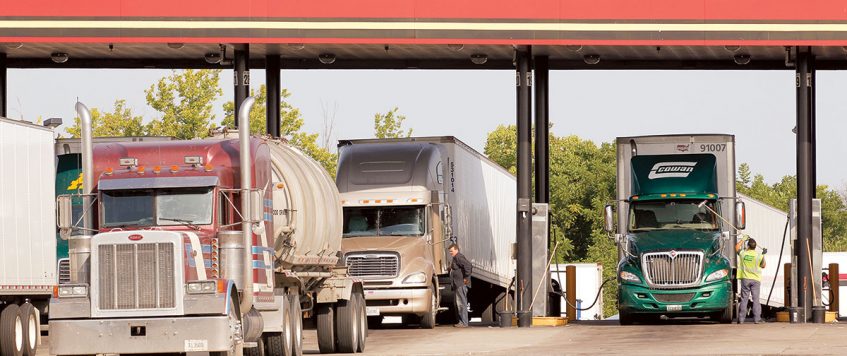-
14
Mar
Fuel Prices Spike Reshaping US Shipping Networks
US shippers are being forced to rethink and reset their transportation budgets as fuel prices soar in the wake of the Russian invasion of Ukraine that unleashed extreme volatility in global oil markets. Beyond the immediate wallop of rapid fuel-related cost increases, shippers face longer-term pressure to change the frequency of shipments, find ways to cut miles from distribution networks, and shift freight among trucking and intermodal rail.
The fuel price spike is big enough to shift the emphasis in US supply chains from speed of delivery to cost, a major reset for shippers focused intently on velocity since the start of the COVID-19 pandemic. How big a reset depends on how high oil and fuel prices go, and whether they remain well above price levels in the second half of 2021.
“I had already included a 10 percent increase in fuel surcharges in my budget, and that’s been blown out of the water,” Holly Pearce, director of logistics at US industrial battery maker C&D Trojan, said in an interview with JOC.com. “Best case, I’ll be paying $1.5 million more, worst case, $3.9 million more, and I already had $7 million baked into my budget for domestic surcharges.”
Overall, US shippers can expect a 4 to 5 percent increase in fuel surcharge costs if fuel prices remain $0.50 a gallon above pre-invasion levels, and that quickly adds up to millions of dollars for large shippers, Ben Cubitt, senior vice president of consulting at third-party logistics provider Transplace told JOC.com. “It could become an 8 percent increase if it goes higher,” he said.
For some shippers, it already has, said Mike Regan, chief relationship officer at software and consulting firm TranzAct Technologies. “You have shippers whose freight costs have gone up 3 to 10 percent over a few weeks,” Regan said in an interview. “When you’re hit with rising fuel prices with no options to fall back upon, how often you ship and who you ship with become very important.”
When shippers prepared their 2022 transportation budgets last fall, fuel costs were already 50 percent higher than in the fall of 2020, averaging $3.68 per gallon in October and November compared with $2.41 per gallon a year previously. As of March 7, the average US diesel retail price was up $1.17 from the average price for October and November, hitting $4.85 per gallon.
The daily average US diesel price published by AAA was $5.13 per gallon Monday, compared with $4.61 per gallon a week ago, $3.89 per gallon a month ago, and $3.07 per gallon a year ago.
The sudden leap in fuel costs — the latest in a long string of disruptive events — will affect the choices shippers such as C&D Trojan make when determining how to move freight within the United States. “This will make us less inclined to ship light truckload, say 20,000 or 22,000 pounds, and we’ll be less inclined to ship LTL as well,” Pearce said. “We’ll wait for a full truckload.”
Speed vs. cost
Until now, speed has been the critical factor for many shippers when choosing US surface modes. With fuel costs and surcharges rising so rapidly, that may change quickly. “We’re going to have to put our foot down with some customers and tell them waiting for one truckload may be better than receiving four separate LTL shipments over a week or two,” Pearce said.
Other shippers will be making similar changes to their supply lines and distribution networks, doing all they can to minimize miles, reduce the frequency of deliveries, and even establish minimum order quantities with customers as a prerequisite to shipping. The shift of freight from intermodal rail to over-the-road truck over the past few years could be reversed.
“All of a sudden, this makes the case for intermodal much stronger,” said Cubitt. “The fuel surcharge for intermodal is about half of that for truckload,” he said. “If the surcharge was $300 for a truckload move and $200 for an intermodal move, this could make the gap much bigger. If a shipper isn’t already shipping long-haul intermodal, this will really push them to do it.”
Switching between modes is complicated by tight capacity on the highway and a shortage of chassis at inland intermodal rail yards, as well as rising intermodal rail fuel surcharges and other factors. There are no easy modal choices for US shippers after two years of COVID-19 pandemic-related disruption.
Shippers will have to rethink how they ship in terms of equipment utilization, not just mode. “Average truckload weights have dropped 10 to 20 percent for shippers over the past year because of network inefficiencies and disruption,” Cubitt said. “That means shippers are using more trucks. If they can eliminate one of every 10 truckload shipments, that’s a big improvement.”
The trade-off between expedited delivery and soaring fuel costs will be at the forefront of shipper negotiations with customers. “You need to look at customers who are ordering more than once a week and talk to them. If those customers want an expedited delivery, they’re going to have to pay for that,” said Cubitt. Shippers, he added, are not going to be able to absorb the elevated costs headed their way.
“Shippers are going to have a different dialogue with their customers,” Regan said. “They’re going to tell them that if this is the delivery schedule you want, this is the price you’ll pay.” In addition to greater shipper-carrier collaboration, there will be more need for collaboration with end-customers, he said. “The question they need to ask is what can we do to work better together?”
By: William B Cassidy / JOC

